|
|
Birth of a Harp Guitar The Story of Wingert HG1-0207.I.M.4 |
|
You might think that, with all of the luthiers listed at harpguitars.net, there would be no real reason to look elsewhere for a new harp guitar. My article Shopping for The Perfect Harp Guitar touched on this subject. I present this article both to show off my spiffy new harp guitar and as a companion piece to that prior article. I hope you will enjoy reading about my experience in working with a luthier building her first harp guitar. I’m lucky enough to have a good friend nearby whom I consider to be one of the top luthiers working in what is widely considered to be a true golden age of guitar making. It has been my good fortune to be able to play many of the guitars Kathy Wingert has made in the last several years and I have found all to demonstrate an exceptionally high quality of workmanship, ease of playability, and a wonderfully rich tonal palette. By the time I signed up for the 2nd annual Harp Guitar Gathering, which took place in November of 2004, I knew I wanted to get a harp guitar. I reasoned that a new instrument would better suit my purposes than a vintage one. Fortunately, I was able to find a nice assortment of modern instruments at the gathering and their owners were kind enough to let me try each one. I had a lot to think about. I recounted my experience at the gathering to Kathy a short while later. I told her that I was having trouble narrowing the field in deciding who I’d want to make an instrument for me. Then, I half jokingly said “I just need to talk you into building a harp guitar”. To my surprise, she said “Start talking”. Kathy’s work has justly brought her a brisk business with her range of 6-string guitars. I never really expected that she would interrupt that to build something different. She didn’t wholly commit to the project then and there but did express significant interest in the idea. We resolved to drive out to Gregg Miner’s Miner Museum of Vintage, Exotic, and Just Plain Unusual Musical Instruments, after the New Year, to learn more about harp guitars. |
|
|
We made the trip in mid January 2005. Gregg was kind enough to take the harp guitars out of the display case for us to hear and examine. Kathy and I both agreed on the Knutsen / Dyer model as our favorite harp guitar form. She was hooked! The only caveat was that she did not want to build a copy of a vintage instrument. We both felt that a Wingert harp guitar should, while influenced by the past, be a fully modern design. I suggested that the body be based on her Model E, my favorite of the body sizes Kathy makes. The Model E (seen at right) is her take on a grand concert sized instrument. Kathy built me a gorgeous 12-fret Model E in 2002. For more information on Kathy’s Model E click here. As Kathy has about a 2 year wait list for her guitars, she agreed to work on the harp guitar as time allowed between other commissions. |
 |
| My wife Christa came up with the next harp head idea and a possible rosette design. I am a huge fan of the work of Scottish arts & crafts period artist, designer, architect Charles Rennie Mackintosh and his wife Margaret MacDonald Mackintosh. The rosette makes use of a variant of the much copied Glasgow Rose design associated with Mackintosh. Kathy and I liked the harp head and agreed to add it to the harp guitar design. |
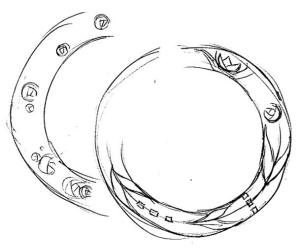 |
|
|
The next step was to think about what woods we wanted to use for the instrument. Given the number of harp guitars, vintage and modern, that use mahogany for backs and sides, I knew that would be an excellent choice for the Wingert instrument. Kathy primarily receives orders for guitars with some sort of rosewood for the back and sides. I didn’t want rosewood on the harp guitar because I have found some rosewood harp guitars that have ended up being too resonant and muddy in the low-end. I prefer a sort of trebly growl in the low notes. My main instruction to Kathy at this time was that I wanted the harp guitar to sound like a Wingert, not a Dyer or Knutsen, and being intimately familiar with her sound signature (though of course somewhat different with different woods and her different body styles) I had some idea about what woods would make a good Wingert harp guitar. For the top, we considered a number of options. Sitka spruce is the easiest wood to find in a size large enough for a harp guitar top but I’ve never fallen in love with a Sitka guitar. Adirondack spruce can be found in large enough planks but my experience with Adirondack guitars is that they have a kind of dry sound and take an awful lot of playing time for the sound to begin to open up. I’ve always been partial to German spruce topped guitars. As exceptional German spruce is getting harder to find, many luthiers are using other European spruces as a substitute. Kathy has found that Italian spruce offers many of the qualities of German spruce with perhaps a little more focused sound. It sounded like a perfect choice for a harp guitar. It took a fair bit of searching but Kathy turned up 2 harp guitar sized Italian spruce top sets from one of her favorite wood suppliers, an Italian company called Rivolta. Kathy ordered both sets in May of 2005 and let me choose which I wanted. The clear choice was the one with a little bit of a bearclaw pattern in it. In June, Kathy had a local wood supplier (Jeff Lunsford) drive down to her place one morning with a van load of possible wood for back and sides. He had a plank of Koa that rang like crazy when tapped. I knew that would make an exceptional guitar but thought that it might prove too resonant for a harp guitar. I settled for the prettiest pieces of mahogany in the van. August brought The 2005 Healdsburg Guitar Festival. I’ve enjoyed going to the festival for some great music, workshops, and hundreds of beautiful guitars to try out. Click here to read my article on harp guitars at this event. |
||
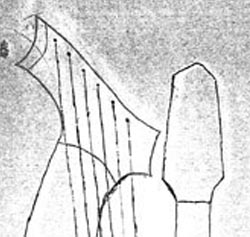 |
During that time, I printed out a copy of a photo of our last design. I covered the harp head, except for the dots designating the tuner locations, and made several copies of the design minus the harp head. I carried these around wherever I went and drew in harp head ideas as they came to me. I drew one similar to Kathy’s original idea to see where we’d come from on the project (upper left). I found I didn’t mind it so much when looking that time. Still, it wasn’t what I really wanted. I came up with a few more ideas, including one that I couldn’t figure out how to finish (upper right). I saw the others (center left and right) as good possible options to present to Kathy, especially the one on the right. Gregg contributed to this version by extending the point into the harp arm (lower left). Kathy, Christa, and Gregg all reacted very favorably but Christa decided that she wanted to draw one more idea for us to consider (lower right). I fell in love with it at first sight! I knew this had to be the one. Kathy agreed to use it. So, by early 2006, we had our basic harp head design. Note that a curved purling line across the harp arm remained from Christa’s more elaborate designs. Further progress would have to wait as Kathy was moving to a new shop location in February and needed time to pack everything and set it up in the new location. |
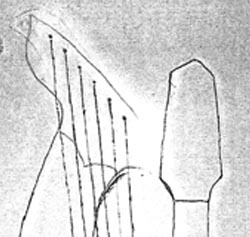 |
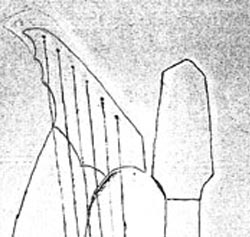 |
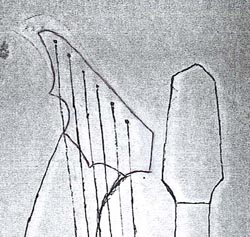 |
|
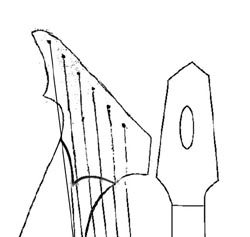 |
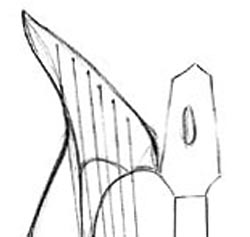 |
|
Serious discussion of sharping levers for the sub-bass strings began in August of 2006. I had become interested in playing music with more complex harmonies and was intrigued by the possibility of not only having a quick way to change the sub-bass tuning for different keys, but also the prospect of using the levers during a given piece of music to add chromatic passing tones in the bass line. Kathy arranged for us to meet with John Peterson at The World of Strings in Long Beach, CA. We looked at a system he devised for extending the range of double basses that has levers that capo the strings onto a fretboard extension. That was a bit too complicated for our purposes but John also had a lot of knowledge of folk harp sharping levers. He steered us to Loveland levers, long a standard for harp levers. Most sharping levers that have been used on harp guitars push up on the string to stretch it to the next pitch. The disadvantage that we saw with that method is that it puts extra stress on the string with each use. The Lovelands fret the string on a small metal dowel. I loved the way Gregg Miner’s Knutsen sounded without nut posts for the sub-bass strings. Duane Noble has also made lovely sounding harp guitars without nut posts. Kathy and I agreed to proceed without nut posts in hope that the open string sound and the sound of the string fretted by the sharping lever wouldn’t be too noticeably different. |
|
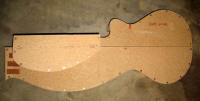
|
After a brief discussion about string spacing, initial construction began. Kathy had already created all of her forms, templates, and molds for the harp guitar. My next visit revealed a braced top and back, bent sides and binding, and inlaid rosettes. I met with Kathy’s daughter Jimmi around this time. Jimmi is the in-house inlay artist. She has a real talent for the work and has been tapped by a number of other luthiers to do inlay projects for them. We discussed a variety of materials for the inlay and agreed that we wanted wood for the rose and a couple points on the figure. The squares would be greenish shell as in the main rosette. I told her to select a material for the white sections that would have the best chance of remaining white over time and would not yellow. She chose Corian. The figure has always seemed somewhat ghostly to me, so we decided to use mother of pearl for the body. All this added up to a somewhat different look than Christa’s original drawing but I feel it works perfectly for the instrument. To see more of Jimmi’s work, click here. |
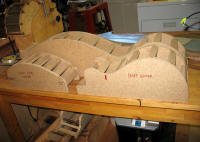
|
|
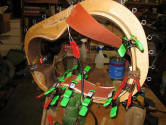 |
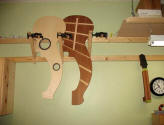 |
||
|
After the holidays, full-scale production began. Of course, Kathy still had guitars to work on for other customers and for the 2007 Healdsburg Guitar Festival, but, I was soon able to hold the assembled body in my lap. The instrument felt absolutely perfect. You’ll notice a slotted headstock on the guitar neck in all the design pictures. I’ve never been a fan of slotted heads. Kathy wanted the slotted head to reduce weight at that end of the instrument and allow easy separation of the guitar and sub-bass tuners. I agreed to the slotted head but wasn’t happy about it. As things were coming together, Kathy decided that she might be able to angle the guitar head back enough to give me my solid head and still allow separation of the tuners. That also allowed a better space to fit the Muse inlay into the guitar headstock. I was thrilled to have my solid guitar headstock. |
|
|
Most of Kathy’s guitars use a traditional dovetail join to attach the neck to the heel in the body. Inspired by Mike Doolin’s work, she opted for a bolt-on neck for the harp guitar. I love Kathy’s guitars with the dovetail and find the change for the harp guitar to make little to no difference as a player. It will, however, make it easier for her if she has to do any work on the instrument at any point that may require removing the neck. Another wonderful thing about working closely with a luthier on a new instrument is that Kathy was able to shape the neck exactly for my hand during this visit. With the box together, Kathy suggested that a Brazilian rosewood bridge might help bring out the sound of the instrument better than the standard ebony. |
|
|
The neck was now ready for Jimmi. She did a beautiful job of bringing Christa’s “Muse” design to life. |
|
|
Meanwhile, Kathy got to work on the binding. She decided to acknowledge the asymmetrical nature of the instrument with this end piece. This is the same cocobolo used on the neck heel and the headstock veneer overlays. |
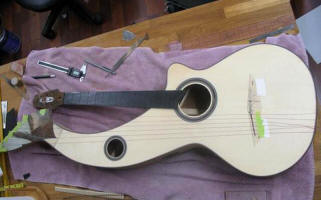 |
With everything together, Kathy made a bridge template and tried it out with dummy “strings.” If you look closely at the photo at right, you will see the side port in the harp arm. |
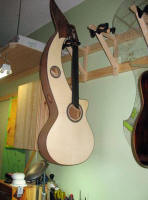 |
|
After hours of sanding everything perfectly smooth, the instrument was ready to have the finish applied. Finish work is very time consuming and it takes a lot of space to have a clean room for finish work. Coat after coat is applied and everything must be sanded after each coating sets so everything is perfectly smooth. Because of this, Kathy, like many other luthiers, sends finish work out to a finish specialist. This was finish expert Addam Stark’s first harp guitar and he took extra time to make sure everything was done perfectly. It was early August when the finish was done. I got to see the harp guitar briefly with finish before the final set-up and assembly. |
|
Christa and I left for vacation shortly after that. Our vacation road-trip eventually led us to the 2007 Healdsburg Guitar Festival where I saw my completed harp guitar for the first time. It was love at first sight and it sounds as great as it looks! Here’s the assembled brain-trust that brought this amazing instrument to life (l to r: Jimmi, Christa, Kathy, Gregg, and I’m in the foreground). . You’ll note that there are no sharping levers on the instrument in the picture. Because of that, we are considering the otherwise completed harp guitar to be a work in progress. Kathy and Gregg determined that my idea of having no nut posts wouldn’t work with the levers. Kathy has ordered some extra parts and will add the levers at a later date if I decide that I can live with the change in tone nut posts would bring. Here are some more shots of the new baby. Note the side port cover, held in place with magnets, in the photo of the instrument from the back. The bracket assembly holding the headstocks together is visible in this picture and the headstock close-up shot. |
|
From commission to completion, this project took about 2 ½ years, most of which was design time. It is true that I could have been playing a harp guitar well before this if I had ordered from a luthier with an established harp guitar design. The problem with that is that I wouldn’t have this harp guitar with that beautiful Wingert tone. I love everything about this instrument and just couldn’t imagine, with all due respect to other fine harp guitar makers, settling for anything else. I went into this project knowing the high standard of Kathy’s work and trusted that standard to create the perfect harp guitar for me. The initial thought of what a Wingert harp guitar could be kept me going throughout the process. What the instrument is will continue to inspire me. |
Addendum
|
The author would like to thank Kathy Wingert for taking on my harp guitar project and for doing such a fantastic job in making the dream become reality! Many thanks must also go to Christa Percival for her design work and for putting up with me while I was obsessing over every little detail of this instrument. Thanks to Gregg Miner for invaluable advice and knowledge throughout the project. Thanks to Jimmi Wingert for her beautiful inlay work. Thanks also to Fred Carlson, Mike Doolin, Benoit Meulle-Stef, Duane Noble, Stephen Sedgwick, and Rick Turner for their thoughts along the way. |
|
About the Author Frank Doucette lives in Los Angeles with his wife, artist Christa Percival (www.percivalproductions.com), and their three young children (parakeets) Riff-Raff, Kina, and Inga. Frank has a Diploma in Fingerstyle Guitar Performance from The Wisconsin Conservatory of Music. Part of his studies there included private harp guitar lessons with renowned author and educator John Stropes. Frank is interested in a wide variety of music and is now working to find his own musical voice in influences such as Celtic music, Brazilian Music, Jazz, and more. An avid history buff, he enjoys studying the cultural and socio-political conditions that have fostered various musical traditions. Before moving to California from his native Massachusetts, Frank taught at, and helped develop instructional manuals for, Wolfman’s School of Music, the only private music school ever to be endorsed by the Berklee College of Music. In his spare time, Frank is a Financial Aid Administrator for the UCLA School of Dentistry. |
| If you enjoyed this page, or found it useful for research, please consider supporting Harpguitars.net so that this information will be available for others like you and to future generations. Thanks! |
|
|
|
All Site Contents Copyright © Gregg Miner, 2004,2005,2006,2007. All Rights Reserved. Copyright and Fair Use of material and use of images: See Copyright and Fair Use policy. |